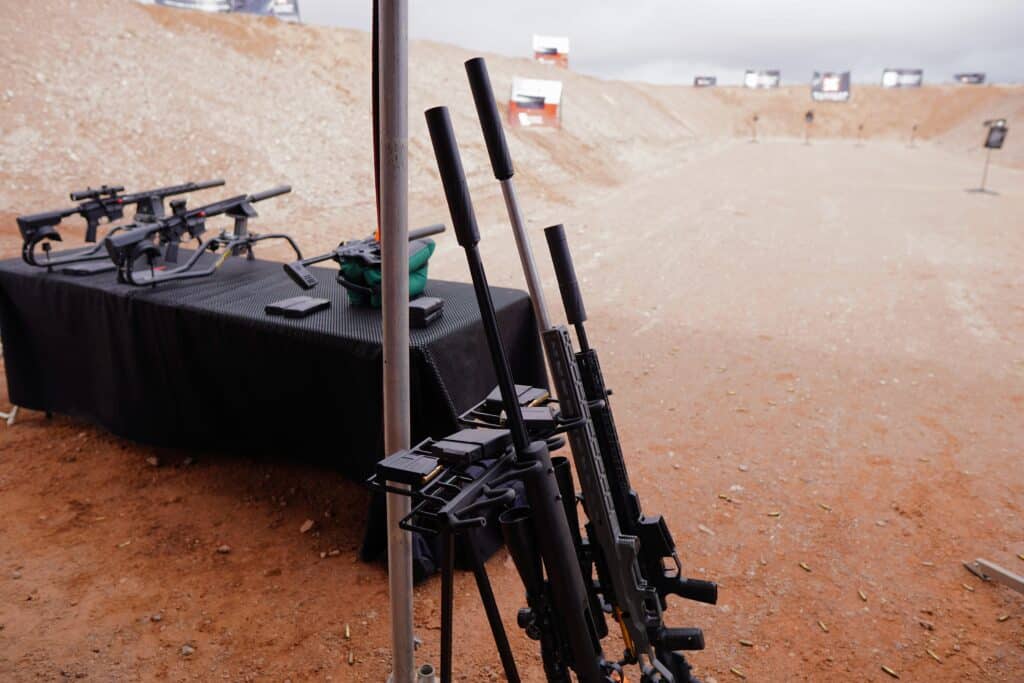The National Rifle Association wants the Supreme Court to throw out Florida’s ban on gun sales to those under 21. It even appears to have been inspired in part by an analysis piece on the topic we recently published.
Contributing Writer Jake Fogleman explains all the reasons the Court ought to take up the case. But will it?
House Republicans also made big news this week when they pushed silencer deregulation the closest it’s ever been to becoming reality. I detail why the GOP’s budget bill and its 50-vote threshold in the Senate present the best shot of getting it across the finish line in decades. But I also outline why it still might not make it there in the end.
Plus, criminologist James Alan Fox joins the podcast to explain the huge decline in mass shootings.

Analysis: The NRA’s SCOUTS Pitch to Overturn Age Limits is Well Positioned for Success [Member Exclusive]
By Jake Fogleman
Outside of gun rights for non-violent felons, few Second Amendment issues have divided the lower courts as much in recent years as age restrictions for certain adults. Now, the country’s largest gun-rights organization is asking the Supreme Court to settle the dispute once and for all.
The National Rifle Association (NRA) recently filed a petition for certiorari in the case NRA v. Glass. The petition asks the Court to review and reverse an Eleventh Circuit Court of Appeals decision from March that upheld Florida’s ban on gun sales to adults under the age of 21.
“A fundamental incident of adulthood in America is the enjoyment of constitutional rights, including the right to defend yourself, your family, and your home with common firearms,” the NRA petition reads. “Stripping away an 18-year-old adult’s Second Amendment rights is thus fundamentally irreconcilable ‘with the principles that underpin the Nation’s regulatory tradition,’ and the Court should grant the writ and reverse.”
The request comes at what seems like an opportune time for enticing the justices to weigh in. As the court of last resort, the Supreme Court tends to avoid hearing issues unless necessary to resolve an active controversy among the lower courts. The Roberts Court has been particularly choosy in recent years.
Still, age-based gun restrictions appear to be a prime candidate for intervention.
In just the last three years since the Court handed down its Bruen decision and its new Second Amendment test, federal appeals courts have split three to two on the constitutionality of restricting gun rights for 18–to-20-year-olds. While the Third, Fifth, and Eighth Circuits have all issued rulings striking down laws that limit the purchase or carrying of firearms for that age group, the Tenth and Eleventh Circuits have upheld total sales bans for them.
Furthermore, the issue is a good vehicle to not only address the threshold question of when people gain full Second Amendment rights, but also a host of additional hot-button questions at the periphery that could assist courts and litigants alike in future gun cases.
For example, one of the key factors that has led courts to arrive at opposite sides of the issue has been the historical period emphasized when searching for analogous regulations to support modern restrictions. Those who have upheld restrictions tended to rely more heavily on Reconstruction-era history when state-level age restrictions began to appear in earnest. Meanwhile, those who have struck down modern age limits have looked more toward the Founding Era, when not only were there precious few age-based gun restrictions, but laws like the Militia Act actually required certain 18-year-olds to be armed.
The Supreme Court implied, but did not say definitively, that it preferred Founding-era history when it laid out its text, history, and tradition test in Bruen. Accepting Glass would allow it to flesh out its position, which would necessarily affect every other Second Amendment case moving forward.
Additionally, the case also allows the justices to address the issue of unenumerated, but implied, conduct associated with the right to keep and bear arms—namely, commercial sales.
In its ruling upholding Colorado’s total sales ban for young adults, for instance, the Tenth Circuit relied on language from the Supreme Court’s Heller opinion referring to “laws imposing conditions and qualifications on the commercial sale of arms” as “presumptively lawful.” It took that to imply that Colorado’s ban did not even “implicate the plain text of the Second Amendment,” and thus upheld it without any historical inquiry.
As Florida’s law is also a sales ban, presumably the Court could clear up its Heller dicta by explaining the extent to which the Second Amendment protects commercial activity. Especially since that argument has found its way into other legal contexts, including waiting periods, enhanced background checks, and licensure requirements for gun sellers.
While the case has a lot going for it in terms of making a compelling cert grant candidate, the Supreme Court’s appetite for it is still very much an open question. The justices recently ducked one opportunity to address age limits when they denied Minnesota’s request to revisit the Eighth Circuit’s ruling on gun carry for 18-to-20-year-olds last month. And they’ve continued to clear their plate of other pending Second Amendment challenges in recent weeks.
One factor that could tip the scales is whether the Department of Justice (DOJ) chooses to take a position. Under the Trump Administration, it has shown a willingness to step in and urge the Court to take up some Second Amendment challenges. It could do so again under its new “pro-Second Amendment” posture.
At the same time, it’s also sometimes shown the opposite inclination. And age limits might be a sore spot for the DOJ. One of the cases driving the current circuit split on age limits came out of the Fifth Circuit, where a three-judge panel ruled in January that the federal 21-year-old age minimum for handgun sales from licensed dealers violates the Second Amendment.
The agency has been ambivalent on that issue thus far. It has twice asked for an extension of time from the Supreme Court so it can decide whether or not it wants to ask for an appeal. It has repeatedly cited President Trump’s executive order on guns for the delay, even though that February order initially gave the agency just 30 days to review its legal positions.
“The President has issued an Executive Order directing the Department of Justice to re-evaluate its litigation positions in certain Second Amendment cases,” Solicitor General John Sauer wrote in his latest request earlier this month. “The additional time sought in this application is needed to continue consultation within the government and to assess the legal and practical impact of the court of appeals’ ruling.”
It’s also worth noting that Attorney General Pam Bondi supported the age-based restriction the NRA is challenging while serving in the same position for Florida. In fact, she was, until recently, the namesake defendant in the NRA’s lawsuit against the restriction. That may also weigh against the DOJ taking an active role in the case’s future.
Regardless, with or without federal government intervention, the NRA has presented a compelling case for the Supreme Court to clear up a lively Second Amendment issue. We’ll know more in the coming weeks if the Court is inclined to do so, or if its recent lull in Second Amendment grants continues.
Podcast: Mass Shootings Have Fallen Dramatically (ft. Criminologist James Alan Fox) [Member Early Access]
By Stephen Gutowski
This week, we’re talking about good news once again.
On our last episode, we spoke with crime data analyst Jeff Asher about what it looks like murder might hit an all-time low this year. Now, we’re talking with criminologist James Alan Fox about how we’ve yet to see a public mass shooting this year.
Fox, a Northeastern University professor who’s studied mass killings for decades, said the tracker he runs for the Associated Press and USA Today hasn’t found a single public mass shooting to date. He noted the decline actually dates back to last year, which saw an unusually small number of mass shootings as well. He argued the trend disproves the idea mass shootings constitute an “epidemic.”
Fox said it’s more reasonable to see mass shootings as rare events that have increased slowly over time, but not a lot more than population growth. He said the recent decline comes after a record high in 2023 and may be the result of the trend returning to its baseline. Still, he argued that the way many media outlets cover mass shootings, and the differing definitions they rely on, tend to mislead the public on their prevalence.
You can listen to the show on your favorite podcasting app or by clicking here. Video of the episode can be found on our YouTube channel. An auto-generated transcript is here. Reload Members get access on Sunday, as always. Everyone else can listen on Monday.
Plus, Contributing Writer Jake Fogleman and I discuss the ins and outs of the silencer deregulation provisions included in the budget package just passed by House Republicans. We explain what they would mean for gun owners and what political hurdles still remain before they can become law. We also cover the Supreme Court’s latest case decisions, including its recent rejection of a whole host of pending challenges to the federal gun ban for non-violent felons. Finally, we break down the DOJ’s recent settlement over forced reset triggers and other gun stories from outside The Reload.

Analysis: Reconciliation is the Best Shot for Deregulating Silencers, But it’s No Sure Thing [Member Exclusive]
By Stephen Gutowski
Silencer deregulation is now the closest it’s ever been to becoming a reality.
On Thursday, the House of Representatives passed its budget bill with a provision that takes silencers out of the National Firearms Act (NFA) of 1934. It now heads to the Senate, where it is a very small part of a very big bill. And a must-pass bill that needs just 50 votes to pass at that.
It may not be smooth sailing once the Senate gets ahold of the bill, though.
Certainly, bundling the effort as part of a much larger budget bill is the best chance it has of getting through this Congress. That 50-vote Senate threshold will be a huge advantage for gun-rights activists backing the bill. There is next to no chance a bill delisting silencers from the NFA could get the 60 votes needed to clear a filibuster. The Hearing Protection Act, a standalone bill that delists silencers, hasn’t garnered a single Democratic co-sponsor for several Congresses in a row, and Mike Crapo (R., Idaho), one of its co-sponsors, recently told me on the podcast it isn’t likely to get more than a few Democratic votes on its own.
The House version fares a bit better, with one Democratic co-sponsor and 85 Republicans. But there are doubts over whether it could get through, given that chamber’s tight margins and likely opposition from Republicans like Pennsylvania’s Brian Fitzpatrick.
So, budget reconciliation offers gun-rights activists more hope of achieving their goal. Certainly, that’s what drove them to savage a less ambitious plan to just cut the NFA’s silencer tax to zero that House Ways and Means Committee Republicans had initially passed. Gun Owners of America went so far as to call it a betrayal and accused the committee of trying to save the NFA’s registration rules.
Those Republicans have argued they aren’t opposed to delisting silencers, but the gun-rights groups are miscalculating on what can get through reconciliation. The sticking point is over what the Senate Parliamentarian will allow under the Byrd Rule. The half dozen sources I spoke with on either side of the fight came to starkly different conclusions about what’s allowed.
The Byrd Rule forbids provisions that deal with “extraneous matters.” There are six definitions for what that means. The most relevant one to silencer delisting is likely the ban on provisions that produce “a change in outlays or revenues which is merely incidental to the non-budgetary components of the provision.”
The gun-rights advocates, as shown in this Gun Owners of America fact sheet, argue the NFA is a tax, and the registration requirements in it are merely mechanisms to enforce that tax. So, eliminating registration and the other regulatory requirements associated with the NFA is not “extraneous,” and delisting silencers should be allowed.
However, the Ways and Means Republicans disagree. They argue since the main goal of delisting is not to affect the NFA’s tax, but rather to eliminate the other requirements in the law, the Parliamentarian will rule against it. They say they looked into the idea of including delisting but were warned by a former Parliamentarian that it wouldn’t work, which is why they went with the tax cut instead.
Still, everyone seems to agree that the Parliamentarian will probably approve eliminating the silencer tax. In fact, some on the gun group side argue the tax provision works as a kind of fallback. That way, even if delisting gets canned, the tax cut can still serve as a consultation.
On the Ways and Means side, they fear delisting silencers from the NFA while also eliminating the tax on them could be ruled as redundant, or the whole section could be tossed out under the Byrd Rule instead of just one part of it. In other words, adding the delisting provision risks ending up with no reform at all.
But that could happen even if delisting or the tax survives the Byrd Rule. The fact that the fiscal impact of the tax repeal is just $1.4 billion over 10 years, a tiny percentage of the overall budget, may work in either direction. It’s unlikely to be enough money to work as a meaningful bargaining chip to settle disputes over things like Medicaid cuts or SALT write-off limits. But it could also easily be swept away if enough Republican Senators think it isn’t worth the squeeze of potentially negative publicity.
That’s one of the risks of the hard-nosed public push the gun-rights groups pursued against the Ways and Means Republicans, which those Republicans didn’t know was coming. If the public backlash doesn’t work, they’ll end up getting what the Republicans they torched were trying to deliver in the first place–or nothing at all. And they’ve likely alienated them, which makes them and perhaps other Republicans less inclined to stick their neck out in the future.
Although if it does work, it’ll have been worth it. Silencer deregulation has been a top priority of the gun-rights movement for a very long time. Plus, if the gun groups prove to be right, the public pushback could convince Republicans they need to take a more aggressive tack going forward to stay in those groups’ good graces–especially since they were savvy enough to suss out the right play.
The ultimate bet is over who is interpreting the Byrd Rule correctly. If the gun groups end up getting silencers delisted from the NFA, I doubt they’ll fret much over whether they alienated some House Republicans along the way. If not, though, their pull on Capitol Hill will be further diminished for no gain.
That’s it for now.
I’ll talk to you all again soon.
Thank you,
Stephen Gutowski
Founder
The Reload







